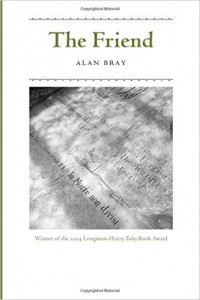 The Friend
The Friend
by Alan Bray
University of Chicago Press
380 pages, $40.
THE FRIEND begins with the author’s dramatic discovery two decades ago at Christ’s College, Cambridge, of a monument marking a tomb in which two men are buried. Placed there in 1684, the monument, as Alan Bray describes it, “is likely to make even the casual visitor pause, for in the engraver’s arrangement, the helmets of the two men seem as if about to kiss. … The arrangement given to the arms of these two men is that of a married couple.” Bray later learned that one of the men, John Finch, routinely referred to his relationship with Thomas Baines as a “connubium” or marriage. Other examples of such friendships abound in The Friend.
Bray’s central argument in this book, which he barely managed to complete before dying, is that there were forms of kinship outside of traditional marriage and family that shaped English culture—and that these family-like bonds were based on the teachings of the Church and were, in fact, blessed by its officials. What’s more, the participants in those ancient forms of ritual kinship were often two men or two women. These rituals used such familiar religious customs as sworn fraternity before church officials—a rite that looked a lot like a wedding—“kisses of peace” and other forms of physical contact, as well as joint burial.
Most historians have tended to ignore “friendship created by kinship” as a significant force in English public life, Bray contends, or diminished its legitimacy by associating it with backward economic and social conditions. A historian at the University of London until his death in 2001, Bray argues—convincingly, I think, with a forensic pathologist’s eye for detail and a novelist’s knack for weaving together divergent plot-lines—that friendship has in fact played a major role in England and all of Europe. This was especially true in the early days, when sanitation and custom dictated that most cooking, eating, and bathing took place outside the conjugal home.
The Friend begins its story around the year 1000 and examines friendship through the late 19th century. We visit the medieval “great houses,” which were places where two men or (much less frequently) two women could bond in ways that look a lot like lovers, even though these were actually political ties between families that could be used for the transfer or extension of property. Unlike modern friendship, Bray contends, traditional “friendship was significant in a public sphere. In modern civil society, friendship has not been perceived to be a public matter, or more precisely ought not to be so.” Moreover, we moderns have lost the ability to conceive of intimate relations between two unrelated people, especially where physical contact is involved, as other than motivated primarily by sex. It is Bray’s contention that the sexual aspect of these bonds, if any, was incidental to their purpose of cementing loyalty between two individuals and their larger social network. In other words, medieval Englishmen kissed, slept together, and shared graves as a way to link their families for political and economic advantage.
Bray concedes that this type of relationship “included the potential for the erotic, as it included much else, with a potential for good and ill alike: self-advancement, the equivocal love for the familiar and the same; but also a capacity to love, and a desire to give, and above all a traditional Christian faith that took as its axiom that the point of religion—what it did for a living—was that it was an instrument by which neighbors, kin and friends could succeed in living in peace with each other.” The kisses, the vows, the joint burials, then, were simply cultural traditions that allowed mortals to find their way together in a crazy mixed-up world—a way of living out one’s belief that the Christian God is the embodiment of friendship.
While making this concession, Bray does go out of his way to minimize the importance of any physical element in these “friendships,” and inevitably pushes his thesis too far. For example, he dismisses as frivolous the language in medieval journals and letters that sure sounds like one man lusting after another or grieving over another man’s absence. These he passes off as the medieval equivalent of real men shaking hands or football players slapping each other on the ass. He seems unwilling to entertain the possibility that it could be a couple of men who’ve found a public way to consecrate their love without running afoul of prevailing anti-sodomy laws.
Concludes Bray: “If this book has a conclusion, it is that there has never been a time when male intimacy was possible in a space untouched by power and politics, however much that was desired or rhetorically projected. But that is emphatically not to deny the reality of that desire or the stature at times even of its failures.” He ends up splitting the difference, chiding those historians who’ve been unwilling to grant the importance of these same-sex bonds as an alternative to strictly familial ones in cementing business relations, but not quite willing to see them as a vehicle that harbored same-sex relationships of a decidedly non-businesslike kind.
Russell A. Jackson is a freelance writer based in West Hollywood.





